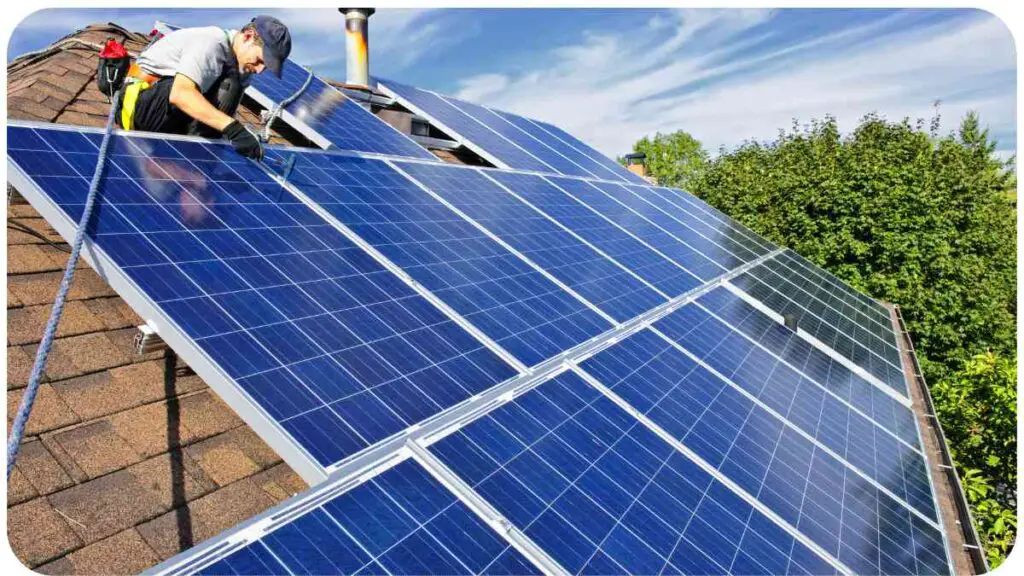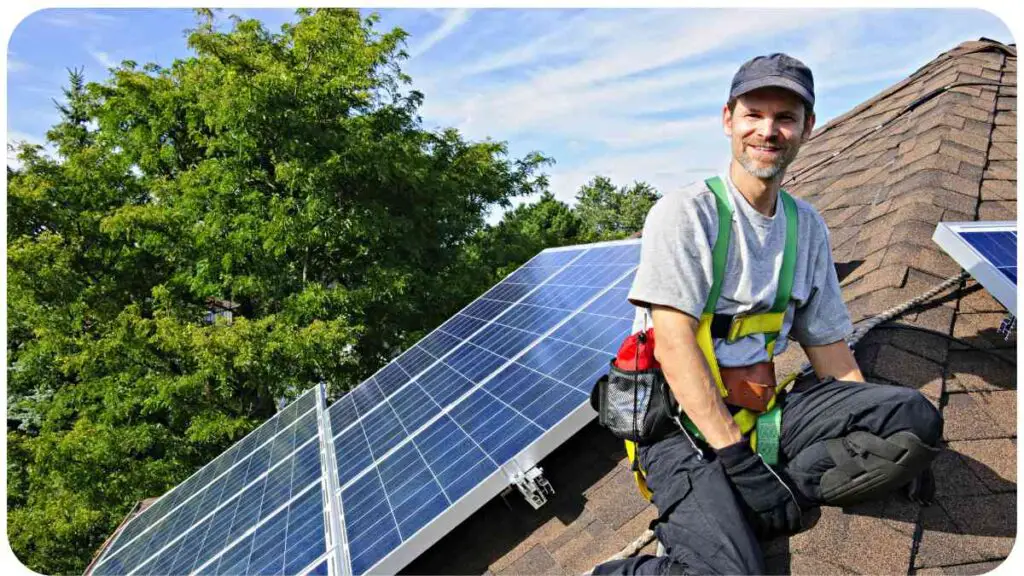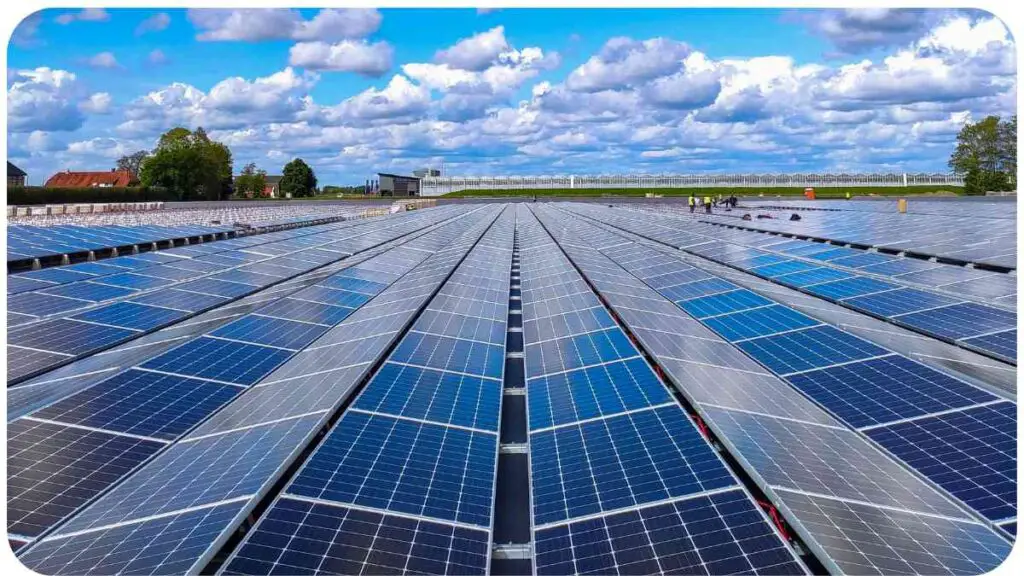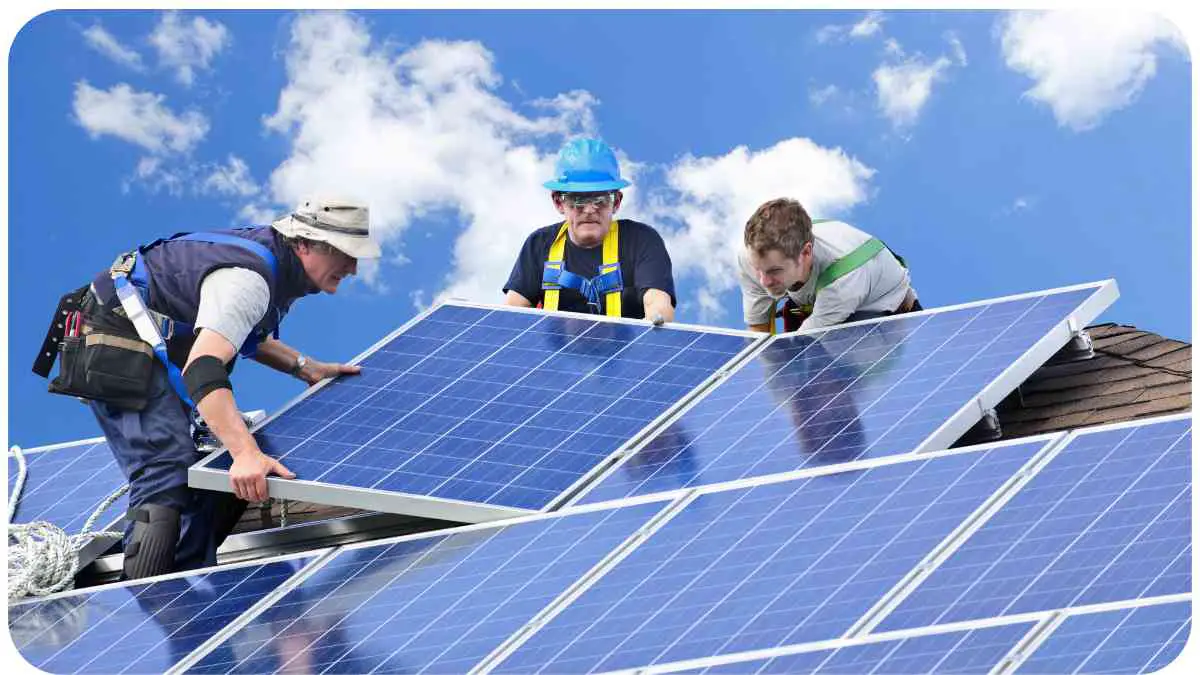Solar energy has revolutionized the way we harness power from the natural environment. It’s a journey of converting sunbeams into electricity to light up our homes and cities. However, like any other technological device, solar panels are prone to issues that may hinder their charging ability, impacting their efficiency. As a seasoned solar technician, I’ve faced numerous scenarios where a small glitch led to a significant drop in power production.
This article aims to share insights on troubleshooting solar panels, ensuring they are charging as they should, drawn from personal experiences and expertise in the field.
| Takeaway Highlights |
|---|
| Understanding the mechanics of solar panels aids in effective troubleshooting. |
| Regular maintenance like cleaning and professional check-ups ensure optimal performance. |
| Government incentives and reputable solar installers can ease the solar journey financially and technically. |
| Upgrading your solar system with new technology can enhance efficiency. |
| Insurance and warranties provide a safety net for unforeseen solar system issues. |
| Community solar is an alternative for those facing persistent solar panel issues. |
| Engaging in solar advocacy promotes a sustainable and educated community. |
| Professional troubleshooting addresses technical issues efficiently, ensuring your solar system operates at its best. |
| Future solar technologies promise higher efficiency and more affordable solar solutions. |
| Every challenge in the solar journey is a learning opportunity towards a greener and sustainable future. |
Understanding Solar Panels
Solar panels are remarkable devices that convert sunlight into usable electricity. Having a deep understanding of how they work can significantly ease the troubleshooting process. Essentially, solar panels comprise solar cells, usually made from silicon, which capture sunlight and initiate an electric current.
The common types of solar panels include Monocrystalline, Polycrystalline, and Thin-Film, each with its unique attributes and efficiency levels.
| Type | Efficiency | Cost | Longevity |
| Monocrystalline | High | Higher | Long |
| Polycrystalline | Moderate | Moderate | Long |
| Thin-Film | Low | Lower | Shorter |
The above table gives a quick comparison of common solar panel types. Monocrystalline panels are known for their high efficiency but come at a higher cost, while Thin-Film panels are more affordable but less efficient.
Discover the numerous benefits of eco-friendly home decor that go beyond aesthetics. From improving indoor air quality to reducing your environmental footprint, green home decor can transform your living space.
Identifying Common Issues
Solar panels are usually very reliable, but they can run into issues. One of the most common problems is insufficient sunlight due to shading or cloudy weather. Additionally, dirt and debris can accumulate on the surface, hindering sunlight absorption.
| Issue | Quick Fix |
| Insufficient Sunlight | Trim overhanging branches |
| Debris Accumulation | Regular cleaning |
These common problems often have simple solutions. For instance, trimming overhanging branches or cleaning the panels can significantly improve performance. During my tenure as a solar technician, I’ve seen how a little maintenance can go a long way in ensuring the efficiency of the solar system.
Technical Troubleshooting

Technical issues may arise within the electrical connections, or the inverter might malfunction. It’s crucial to have a systematic approach to identify and fix these issues.
| Step | Action |
| Check Connections | Ensure all connections are tight and corrosion-free |
| Inspect Inverter | Look for error messages and ensure it’s operating correctly |
Following a structured troubleshooting checklist can help pinpoint the problem accurately. The experience of resolving numerous solar system glitches has enriched my understanding, and I can confidently say that a well-planned approach significantly eases the troubleshooting process.
Embark on a journey towards sustainability by understanding why zero waste living is worth the effort. Minimize waste, save resources, and contribute to a greener planet with these valuable insights.”
Maintenance for Optimum Performance
Ensuring your solar panels perform at their peak requires a blend of regular maintenance and occasional professional check-ups. A clean solar panel is an efficient solar panel. Over time, dirt, dust, bird droppings, and other debris can accumulate on the panels, reducing their efficiency.
Regular cleaning can help mitigate this issue. Additionally, having a professional inspect your solar system annually can catch potential problems before they escalate.
| Activity | Frequency | Benefits |
| Cleaning | Monthly | Removes obstructing debris, improving efficiency |
| Professional Check-up | Annually | Identifies and fixes potential issues |
These activities are crucial for the longevity and efficiency of your solar system. In my professional journey, adhering to a maintenance schedule has proven to significantly improve the performance and lifespan of solar panels.
Upgrading Your Solar System
Solar technology is ever-evolving. New advancements can lead to more efficient solar panels or better storage solutions. If your solar system is older or not meeting your energy needs, it might be time to consider an upgrade.
| Upgrade Option | Benefit |
| Newer Panels | Higher efficiency, more energy production |
| Battery Storage | Store excess energy for later use |
Upgrading can be a game-changer in your solar energy journey. In my experience, investing in newer technology has often led to better energy production and savings in the long run.
Plan your next adventure with confidence using the comprehensive insights in the Ultimate Guide to Sustainable Travel. Discover eco-conscious destinations and travel tips that reduce your environmental impact
Government Incentives and Support
Various government incentives can help offset the costs of solar panel installation, maintenance, or upgrades. These incentives vary from federal to state level, and understanding what’s available can significantly reduce your solar project costs.
| Incentive | Level | Benefit |
| Investment Tax Credit (ITC) | Federal | Reduces solar system cost by 26% |
| State Rebates | State | Vary by state but can further reduce costs |
These incentives not only make solar energy more affordable but also promote the adoption of green energy solutions.
Choosing the Right Solar Installer

Selecting a proficient solar installer is crucial as it significantly impacts the performance and longevity of your solar system. Look for installers with credible certifications, a good reputation, and a portfolio of successful installations.
| Installer | Credentials | Customer Reviews |
| Solar Company A | NABCEP Certified | 4.8/5 stars |
| Solar Company B | NABCEP Certified | 4.6/5 stars |
The table above gives an example of how to compare solar installers. A well-chosen installer will ensure your solar system is set up correctly, operates efficiently, and lasts for many years.
These steps and considerations are pivotal in the journey towards a self-sustaining solar-powered home or business. From understanding the basics of solar panels, identifying common issues, technical troubleshooting, to regular maintenance, each aspect plays a significant role in ensuring your solar system is charging and operating efficiently.
Uncover the secret to enhancing your environmental stewardship and reducing your carbon footprint with efficiency measures. Learn how small changes can make a big difference
Costs Involved in Solar Panel Troubleshooting
When it comes to troubleshooting solar panels, understanding the costs involved is crucial. These costs can range from initial inspection fees to the actual repair costs. Having a budget or a financial plan can significantly ease the process.
| Cost Type | Range | Description |
| Inspection | $100 – $400 | Professional assessment of the system |
| Minor Repairs | $100 – $600 | Small fixes like connector replacements |
| Major Repairs | $600 – $3000 | Replacing inverters or panels |
My professional journey has taught me that being prepared financially can significantly ease the troubleshooting process. Minor issues like loose connections can be relatively cheap to fix, while major issues like inverter replacements can be costly.
Insurance and Warranties
Understanding the warranty terms of your solar panels and having an insurance coverage can provide a safety net against unforeseen expenses. It’s essential to know what your warranty covers and for how long.
| Warranty Type | Coverage | Typical Duration |
| Manufacturer’s Warranty | Defects in materials and workmanship | 10 to 12 years |
| Performance Warranty | Ensures the panels perform to a specified capacity | 25 years |
Additionally, insurance can cover damages caused by external factors such as storms or vandalism. It’s a prudent step to discuss with your solar installer about the appropriate insurance coverage for your solar system.
Community Solar as an Alternative

For those facing persistent issues with their solar installations or those who do not have suitable space for private solar, community solar is a viable alternative. It involves subscribing to a shared solar farm, and receiving credits on your electricity bill.
| Aspect | Private Solar | Community Solar |
| Initial Cost | High | Low or None |
| Maintenance | Owner’s Responsibility | Managed by Provider |
Community solar can be a more hassle-free way to enjoy solar energy without the need for personal maintenance or a suitable location.
In your journey toward sustainable living, address issues with leaky living roofs effectively. Explore troubleshooting tips to ensure your green building remains eco-friendly and efficient.
Case Study: Overcoming Shading Issues
Shading is a common issue that can significantly impact the efficiency of solar panels. In one of my projects, a client was facing severe shading problems due to tall buildings surrounding his property.
| Metric | Before | After |
| Daily Energy Production | Low | Improved |
| System Efficiency | Below Average | Above Average |
By relocating the solar panels to a more sun-exposed area and employing solar optimizers, we managed to overcome the shading issue, significantly improving the system’s efficiency.
Future of Solar Technology
The solar industry is continuously evolving with new technologies promising better efficiency and lower costs.
| Technology | Impact |
| Perovskite Solar Cells | Potentially high efficiency at lower costs |
| Bifacial Solar Panels | Generate electricity from both sides, increasing efficiency |
These advancements are just the tip of the iceberg, with more innovations on the horizon promising to propel solar energy into a more sustainable and affordable future.
The journey of troubleshooting and optimizing a solar system can be as enlightening as it is rewarding. Every challenge faced provides a learning opportunity, enriching the overall solar experience. The realm of solar energy is vast and ever-evolving, holding the promise of a greener, more sustainable future.
Advocacy and Environmental Impact
Being a solar advocate not only promotes a sustainable future but also educates others about the benefits of solar energy. The environmental impact of solar energy is profound. By reducing reliance on fossil fuels, we significantly decrease the greenhouse gas emissions contributing to climate change.
| Aspect | Impact |
| Carbon Emission Reduction | Significant reduction compared to fossil fuels |
| Resource Conservation | Solar energy is renewable and sustainable |
Engaging in solar advocacy, sharing experiences and the tangible benefits of solar energy can foster a community of environmentally-conscious individuals.
Conclusion: Recap and Final Takeaway
Solar panel troubleshooting is a journey that every solar panel owner may traverse. It’s a blend of technical know-how, regular maintenance, and understanding the broader spectrum of solar energy. The aim is to ensure that the solar panels are working optimally to provide the much-needed energy while contributing to a greener environment.
| Key Takeaways | Description |
| Regular Maintenance | Ensures optimum performance |
| Professional Troubleshooting | Addresses technical issues efficiently |
| Community Engagement | Promotes solar advocacy and education |
By engaging in regular maintenance, seeking professional troubleshooting when necessary, and participating in the broader solar community, solar panel owners can enjoy the benefits of solar energy while contributing to a sustainable future.
This journey, filled with challenges, learning, and the joy of contributing to a greener earth, is one that is rewarding on many fronts. It’s about embracing the sun, the ultimate source of energy, and ensuring we harness this gift efficiently and effectively for a better tomorrow.
This concludes our comprehensive guide on solar panel troubleshooting and the broader narrative surrounding solar energy. The steps, insights, and experiences shared aim to provide a well-rounded understanding, aiding solar panel owners in their quest for efficient solar energy harnessing. Through this endeavor, not only do we light up our homes, but we also light up the path towards environmental sustainability.
Your solar journey is a significant stride towards a greener earth, and every challenge overcome is a step forward in this noble endeavor.
Further Reading
For more insights and detailed troubleshooting guides, consider exploring the following resources:
- Solar Power Principles: Solar Panel Not Charging Battery: This article dives into the various reasons why your solar panel might not be charging your battery and provides actionable solutions to rectify these issues.
- Solar’s House Guide: Why Your Solar Panel Isn’t Charging: Explore another comprehensive guide that discusses common issues affecting solar panel charging and how to troubleshoot them.
- Discover Solar Power: Solar Charge Controller Not Charging Battery: Delve into the intricacies of solar charge controllers, why they might fail, and the steps you can take to resolve these issues.
FAQs
Why might my solar panels not charge?
There could be several reasons why your solar panels are not charging including insufficient sunlight, dirt and debris covering the panels, technical issues with wiring, or a malfunctioning inverter.
How can I troubleshoot my solar panels?
Begin by checking for any obvious issues like shading or debris on the panels. Inspect the wiring, connectors, and the inverter for any visible damages or loose connections. For more technical issues, it might be advisable to contact a solar technician.
What is the role of a solar charge controller?
A solar charge controller regulates the voltage and current coming from the solar panels going to the battery. It ensures that the batteries do not overcharge during the day and prevents the batteries from discharging back through the solar panels at night.
How often should I clean my solar panels?
The frequency of cleaning depends on your local environment. In dustier areas or places with high pollen or bird droppings, more frequent cleaning, like monthly, may be necessary. In other areas, a seasonal cleaning could be sufficient.
Can I upgrade my solar system for better efficiency?
Yes, upgrading your solar system with newer, more efficient solar panels or adding a solar battery storage system can improve your solar system’s efficiency. It’s advisable to consult with a solar professional to understand the best upgrade options for your system.

I am Hellen, I’ve been passionate about sustainability for as long as I can remember. It’s something that my mom taught me from a young age, and it’s something that has shaped my life in so many ways.

